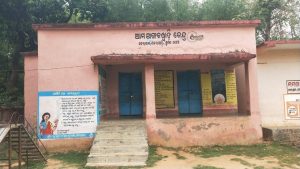Pre-school edu goes haywire in Mayurbhanj

Baripada: With the implementation of the National Education Policy (NEP) 2020 this academic year, significant changes have been introduced in the state’s education system to improve enrollment rates. The government has also launched ‘Khadi Chhuan’ programmes under ‘Sishu Vatika’ initiative to encourage early childhood education.
However, in rural areas, preschool education continues to face challenges. Many Anganwadi Centres (AWCs), which serve as the primary means of early education for young children, operate from rented spaces. This has raised concerns about the effectiveness of government initiatives in ensuring quality education.
In Mayurbhanj district, there are 5,152 AWCs across 26 blocks, two municipalities, and two Notified Area Councils (NACs). However, 1,055 of these centres lack permanent buildings or foundational infrastructure, while 293 operate in rented accommodations. Additionally, 180 AWCs function in community buildings, and 582 are housed in school buildings, which many parents consider unsafe for the children.
As a result, parents hesitate to send their children to these centres and increasingly opt for private schools instead. Although there are plans to construct new AWCs, some projects remain incomplete while others are still under construction. The lack of proper infrastructure has hindered the successful implementation of programmes related to teaching, mid-day meals, play-based learning, and educational gardens. The absence of hygienic learning environments and the need for children to study on the floor have also negatively impacted their educational experience. These factors have led to declining trust in AWCs, driving parents to enroll their children in private schools instead. As a result, the district’s early childhood education system has been severely disrupted.
Despite the District Collector’s repeated monthly reminders to Block Development Officers (BDOs), the issue remains unresolved. The lack of accountability and neglect by officials and staff has led to this disorder, according to Purnendu Basang, Shakti Basang, and Dipu Basang, parents from Belpal village in Badasahi block. They pointed out that not a single AWC has been built in the area for the past 20 years. The district has a total of 2,45,441 beneficiaries, including 1,13,632 children aged three to six months, 12,764 postpartum mothers, 17,392 pregnant women, 12,452 infants under six months, and 89,201 children between six months and six years old.
However, the schemes intended for them have largely failed. When questioned about the situation, District Social Welfare Officer Niharika Mahati stated that all necessary measures have been initiated under the District Collector’s directives. Construction efforts are ongoing through municipal authorities in urban areas and block administrations in rural regions.
However, delays have prevented the completion of these projects, making existing AWCs ineffective. To improve child recreation facilities and enhance the health and nutrition of pregnant and postpartum women, a plan has been launched to transform AWCs into model centres. The Odisha Mineral Bearing Areas Development Corporation (OMBADC) had earlier prepared a blueprint to upgrade Mayurbhanj district.
In 2019, OMBADC proposed a Detailed Project Report (DPR) worth Rs 528 crore to construct 826 required AWCs. Each centre was allocated Rs 15 lakh, while funds ranging from Rs 4.5 lakh to Rs 7.5 lakh were set aside for renovating existing ones. In the first phase, OMBADC approved funding for 346 model AWCs in 2021-22, with construction beginning shortly thereafter. Of these, 300 centres have been completed, while work on 46 remains in progress.
However, funding approval for an additional 480 centres has been pending despite multiple notifications from the administration to the concerned departments. Parents have expressed concern that unless early education is prioritised under the NEP 2020, both Central and state government schemes will fail to achieve their objectives.
News